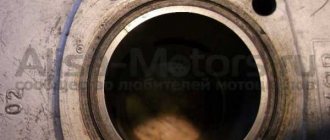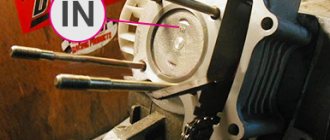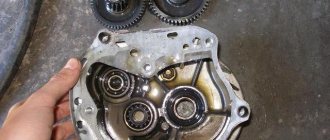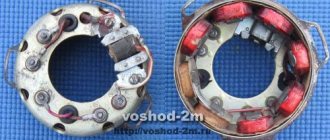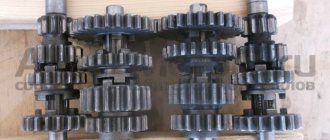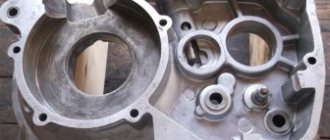In matters of choosing one or another engine repair strategy. When it comes to repairing Soviet two-stroke motorcycles, it is advisable to adhere to a strategy that involves the complete restoration of original parts. And if this is not possible, with a creaky heart, you are forced to buy counterfeit goods or look for a used option.
- In the case of piston engines, a good repair involves, first of all, boring the cylinder to the repair size and installing a new piston, rings and pin. If you are lucky enough to find a Soviet-made cylinder, the best option would be to bore it to repair size, install a new piston, albeit a counterfeit one, and then such a piston is guaranteed to last for several seasons. And what’s most important is that boring costs only 400 rubles + a new piston, rings, pin, the total cost is no more than 1000 rubles
There is little point in dwelling on the boring process in detail. Boring involves restoring the geometry of the cylinder by increasing its diameter. You don't need to know more about boring. There are turners, let them bother with these subtleties
- If you don’t bother, as they used to like to do on collective farms: choosing a larger piston for a worn-out cylinder, then such a “repair” will be enough to take you to the neighboring collective farm for moonshine a couple of times...
- The fastest repair option is to buy a new piston. Our prices for piston engines for Soviet motorcycles start at 3,000 and more. To buy or not to buy is up to you. But if you buy it, be prepared for surprises.
Photo report: Installing a piston on a motorcycle “Izh”, “Ant”, “Voskhod”
In matters of choosing one or another engine repair strategy. When it comes to repairing Soviet two-stroke motorcycles, it is advisable to adhere to a strategy that involves the complete restoration of original parts. And if this is not possible, with a creaky heart, you are forced to buy counterfeit goods or look for a used option.
- In the case of piston engines, a good repair involves, first of all, boring the cylinder to the repair size and installing a new piston, rings and pin. If you are lucky enough to find a Soviet-made cylinder, the best option would be to bore it to repair size, install a new piston, albeit a counterfeit one, and then such a piston is guaranteed to last for several seasons. And what’s most important is that boring costs only 400 rubles + a new piston, rings, pin, the total cost is no more than 1000 rubles
There is little point in dwelling on the boring process in detail. Boring involves restoring the geometry of the cylinder by increasing its diameter. You don't need to know more about boring. There are turners, let them bother with these subtleties
- If you don’t bother, as they used to like to do on collective farms: choosing a larger piston for a worn-out cylinder, then such a “repair” will be enough to take you to the neighboring collective farm for moonshine a couple of times...
- The fastest repair option is to buy a new piston. Our prices for piston engines for Soviet motorcycles start at 3,000 and more. To buy or not to buy is up to you. But if you buy it, be prepared for surprises.
Quality of parts
The “quality” of parts for Soviet motorcycles that are currently on sale does not correspond to even the worst Soviet models. The Soviet one was not ideal either - believe me. The only thing there were no complaints about was the quality of the metal, but the manufacturing accuracy of Soviet manufacturers was lame and very, very bad
Rings
When purchasing new rings, insert them into the cylinder (new or after boring) and check for clearance
- If the rings fit tightly, we buy
- If the rings do not fit the mirror, try others
An example of a perfect fit of a ring to a mirror (“Ant”)
After checking for fit, we put the rings on the piston and measure the gap between the ring and the piston groove with a feeler gauge.
- If the gap is greater than 0.01-0.02 mm, try another ring
- If after several tried rings the gap is larger than expected, we try another piston
Voskhod piston with a gap clearly exceeding all conceivable standards
“Ant” piston with permissible clearance
Piston
One of the most dangerous and common problems in new pistons is the incorrect position of the ring stoppers. Customers have already brought pistons several times that had problems with the location of the stoppers
- Before purchasing a piston, use some pliers to tug on the stopper
- If the stopper is wobbly, we debug this piston and take the next one for check
Consequences of a flying stopper (“Ant”)
If the stopper fits tightly, place marks opposite the stoppers and insert the piston into the cylinder so that it does not reach the windows. Afterwards, we turn the piston so that it becomes exactly the same as in the engine. That is, the arrow is forward, and the axis of the finger is strictly along the axis of the crankshaft and look:
- If at least one risk has become opposite the windows or next to the window, we debug the piston and take another
- If there are risks between the windows, we buy
An example of the incorrect placement of stoppers on the assembled Voskhod engine. If the ring lock is in this position, the ring will inevitably break
An example of the correct position of the stoppers (“Ant”)
Review of the new piston for Ant
What is better, buy a new piston or buy a used Soviet-made cylinder and then bore it to repair size?
It is impossible to answer this question unequivocally. Since everything depends on many factors, the main one of which is access to a good repair base and access to good used parts. Everything depends on this. There are still good craftsmen, and if you know a turner at some military factory, then the best option for you would be to go through all the surrounding sheds, choose a cylinder that is more or less acceptable in condition and give it to “Uncle Vasya” at the factory for boring. And buying a new piston, pin and rings will be the best option. If you don’t know “Uncle Vasya”, there is only one way: buy homemade bullshit in the store and then fuss with it for a long time and tediously.
A complete set of a new piston engine of unknown origin “before the increase” cost 4,000 rubles:
- Head — 600 rub.
- Cylinder with piston, pin and rings - RUB 3,000
- Reed valve assembly with body and gaskets - 400 rubles
Pistons for TMZ engines, which are now on sale, most likely factory-made. And most likely ours. Some parts show traces of factory processing, in some places there are even stamps, but the piston pin is clearly Chinese: it shines and is packaged: our factories don’t do that.
By default, the cylinder head comes with a solid “jamb”: the plane with which it rests on the cylinder is curved. Such a head cannot ensure the tightness of the connection. Fortunately, the problem is easily solved: grind the head on the stove and voila!
Dark places indicate leaks through which gases escaped from the combustion chamber. The head is not new, it was a little similar, but it is from the same opera as the cylinder
Even a new cylinder has a difference between the sleeve and the jacket, while a used one becomes even larger
Honing is applied to the cylinder mirror. The mirror itself is made with high quality, it is clear that the metal from which the sleeve is made is good, and not raw. It’s just a pity that the manufacturing accuracy is poor
There are many casting flaws on the vent windows. Before installation, it is advisable to remove all this disgrace
The piston is of very good quality: the locking pins do not fly out, the piston pin fits into the bosses with the required tension, the position of the locking pins fully corresponds to the position of the windows in the cylinder
There is a factory mark on the piston
The gap between the groove and the piston ring is within normal limits
The position of the piston ring locking pins is ideal: marks are drawn opposite the locking pins, the cylinder is installed on the engine
The piston rings are also of good quality
The fit of the rings to the cylinder mirror is ideal, the gap in the lock is minimal
In general, if you do not take into account the problem with the difference between the sleeve and the jacket, then this piston could easily be called good.
Source
Preparation
Russian is Russian, so until we process all the parts properly with a file before installation, nothing will work out...
Insert the cylinder rings and use a feeler gauge to measure the gap in the lock.
- If the gap is less than normal, file the ends of the rings with a file
To reduce engine noise and speed up the ring grinding process, remove small chamfers on their working edges (preferably)
To improve lubrication of the piston pin, use a 5-6 mm drill to drill through holes in the piston bosses (optional)
We remove flashes and deposits of metal in the cylinder windows and round the edges along which the rings go
After finishing work, we thoroughly wash all the parts, prepare a clean work area and begin assembly.
Cylinder
Unfortunately, you can’t really check anything in the cylinder by eye. Therefore, we inspect his mirror for damage and that’s it.
Example of a new cylinder mirror
Example of a mirror after boring
Assembly
Insert the retaining ring into the piston boss. The ring should fit into the boss tightly and evenly around the entire circumference
- If the ring is not seated tightly, straighten it or replace it with a new one.
We heat the piston with a technical hair dryer and insert the piston pin into the boss so that it extends slightly inside the piston
Lubricate the upper connecting rod bushing with any engine oil. We turn the piston with the arrow towards the exhaust (on Jupiters - towards the inlet). We put the piston on the connecting rod, insert the extended pin into the hole in the upper head, drive the pin in and fix it with the second lock ring
We install the gasket and, from some clean container, bury engine oil into the bearing of the lower head of the connecting rod and the oil channels of the main bearings
Lubricate the piston thoroughly with oil, install the rings and tighten them with a clamp. We make a clamp from tin: cut out a strip of the required width, use it to make a clamp and voila!
After the rings go into the cylinder, remove the clamp and push the cylinder all the way
After installing the cylinder, hold it with your hand and try to turn the crankshaft:
- If the piston moves easily in the cylinder without crunching or jamming, install the gasket and screw on the cylinder head
- If the piston moves tightly with a crunching sound, or sticks, remove the cylinder and see what you did wrong
Spare parts price
Despite the fact that the production of the device stopped long ago, you can still find new spare parts for it that are produced by the industry. Some parts are imported, some come assembled. Supplied in sets:
The necessary parts can be found on the Internet using store catalogs. Prices for spare parts for the Ant scooter are fair. Here are some examples:
Judging by the prices, the device is more than cheap to repair. This is an important operational property for people in rural areas.
In terms of tuning the Soviet Ant vehicle, the owners can’t think of anything.
After all, these are often tech-savvy people who like to spend time in the garage. Several areas can be distinguished:
The main task when tuning is to increase reliability and less tinkering with details due to breakdowns.
In terms of engine tuning, some owners took radical measures and installed a Lifan engine (Lifan 188f), which has a volume of 400 cubic meters, on the Ant scooter. cm. And its power is 13 hp. A distinctive feature of this assembly is the variator and centrifugal clutch.
A centrifugal clutch is not the best option for trucks, since when driving on rough terrain on a loaded scooter at low speeds, it may slip. And this incapacitates him.
What modifications of the “Ant” scooter are there in the video:
First of all, we note that the engine of a cargo scooter works under more intense conditions than that of any road motorcycle, and the transmission ratios here are higher: otherwise it will not be possible to carry this or that load. Therefore, to achieve the same speeds, the engine must develop high speeds, which means its service life is reduced, maintenance has to be carried out more often, and the amount of work increases. True, the techniques and order of repair operations for the most part do not differ from those that have to be done on a regular Tulitsa or any motorcycle.
The most common defect in an engine today is the destruction of the bearing cage in the lower head of the connecting rod. This may be a consequence of a lean mixture and the associated lack of lubrication, incorrect choice of oil or violation of its proportion in the fuel, poor mixing of oil with gasoline, etc.
Leaning of the mixture occurs not only due to carburetor clogging. For example, oil that is not mixed with fuel can settle in the sump of the gas tap and clog its mesh. If the same mesh has not been cleaned of mechanical contamination for a long time, expect trouble. Be careful when installing the sump gasket: it may block the fuel channels. We would like to remind you about the banal thing - blocking the hole in the gas tank cap - how many engines were “screwed up” due to such a “small thing”.
Finally, about the difference in fuel levels in the tank and the carburetor float chamber: with the Ant it is very small. And therefore, if there is little fuel in the tank, and the load on the engine is high (high speed), there may not be enough fuel. This means the mixture is lean again, and expect trouble.
The life of bearing cages largely depends on the running-in conditions. It is impossible, having maintained a given speed for the first 2 thousand kilometers, to immediately “squeeze” everything that it is capable of from the car. It would be more correct to increase the loads gradually, adding them slightly every 500-600 kilometers and monitoring the behavior of the engine and its thermal regime.
In addition, although the factory stated that the engine develops speeds of up to 5000-5500 per minute, these modes cannot be considered normal. But in practice they are not that uncommon.
Thus, improper running-in and “over-twisting” of the engine is a real way to destroy the bearings. And another very important recommendation - do not suddenly release the gas when going to idle - the supply of the mixture almost stops, and the crankshaft continues to rotate for some time at high speeds. Failure to comply with this condition most often leads to jamming of the crankshaft. Well, what if this happened? Although the crankshaft of a scooter engine is considered non-separable, since its parts are press-fitted, it can be disassembled if you have at least some kind of simple press. Or even a puller - but quite powerful.
Refinement of the Ant scooter. Page 2 of 2
I remember an ant like a bad dream, and it didn’t travel 60 km. If it’s only downhill, then you think that the wheels won’t fly off.
Well, if you don’t regulate it correctly, then of course it won’t work. Here in Tula they still run. And I, Ant and Tula had them in our youth. And they ran without problems. It’s just that there was such a technique back then, you had to put your hands to it, to any one. Now I’m moving out of town, I’m picking up an Ant for the summer, an irreplaceable thing in the household. And by the way, for a vehicle, in order to make a sleeping kung, it is not necessary to increase the platform. You can simply make the front wall fold down and get a full-fledged sleeping place.
The walk-behind tractor drives quietly, right? Oh well
Hi all . Please tell me! You can put a piston from an old-style ant onto a new-style ant. I ask because on the old-style ant the piston has 3 rings, and on the new-style ant the piston has 2 rings and a window on the carburetor side. I can’t take a photo because my friend’s ant is far from me.
Hi all . Please tell me! You can put a piston from an old-style ant onto a new-style ant. I ask because on the old-style ant the piston has 3 rings, and on the new-style ant the piston has 2 rings and a window on the carburetor side. I can’t take a photo because my friend’s ant is far from me.
Dynastarter
However, it is not only the engine that can make a motorcyclist clearly see all the components of his motorcycle. The most common problem is a problem with the dynastarter . The engineers of the Tula plant installed it in Muravya, instead of a conventional alternating current generator.
Why is it so important? If you notice a red light on the instrument panel while the moped is running, it means you are running out of charge. This happens because the generator is not producing alternating current. To begin with, in such a situation, it is necessary to check the integrity of the wires connected to the dynastarter and the relay regulator. If everything is in order, then the problem lies directly in the dynastarter. There may be three main causes of problems:
- difficulty in rotor operation (dirt getting into the collector or dust accumulation);
- freezing or wear of brushes;
- violation of the integrity of electrical equipment.
MY MOTORCYCLE
Everyone knows that: the power and “thrust” of the engine directly depend on the condition of the parts of the cylinder-piston group. You also know that the friction surfaces of these parts wear out due to dust, the use of low-quality oils, and simply from prolonged use. Since it is practically impossible to measure engine power in everyday conditions, many use an indirect indicator - maximum speed, while others measure compression in the cylinder. The second method of assessing power is more preferable, because the speed capabilities of the device may decrease, for example, due to the fact that the exhaust system is coked, the ignition control is disrupted, or the carburetor malfunctions. If the engine is really stuck, do not rush to immediately bore the cylinder to the repair size. Experienced people usually adhere to the following sequence of actions: the first time they change the rings, the second time - the rings and the piston (both times - to nominal sizes), then they change the rings again (also to nominal sizes) and only then bore the cylinder for the first repair with subsequent installation of a repair piston with rings. When to start these replacements depends mainly on the operating conditions. The first replacement of the rings may be necessary after six to seven (and up to 25 for large-capacity devices) thousand kilometers, and the piston after 15-40. The degree of wear can be assessed by disassembling the cylinder-piston group. When disassembling, you need to firmly remember two things.
First, don't drop the retaining ring into the crank chamber. To avoid this trouble, immediately cover the camera with, say, a rag.
And second, don’t bend the connecting rod when you start knocking out the pin with a hammer. It is best to use a puller. So, the piston is in your hands. Carefully remove the rings from it (use three or four shims (Fig. 1) and insert them into the top of the cylinder.
“Align” the rings with the piston - insert it into the cylinder from below and measure the gaps in the ring locks (Figure 2). If they exceed 3 mm, the rings must be replaced. Gaps in the locks of new rings should not exceed 0.2-0.4 mm.
Immediately evaluate the condition of the piston: if the gap between it and the cylinder is more than 0.3-0.4 mm, the piston requires replacement. When selecting a new piston, it is convenient to follow the “old-fashioned” method: a washed and lubricated cylinder lies on the table, and you lower the piston into it. A “good” piston should lower under its own weight for about one second. If it fails with a knock or, even worse, gets stuck “halfway,” look for another piston. Each motorcycle model has from two to four size groups of pistons; their difference in diameter can be from 0.01-0.025 mm. The group marking is usually stamped on the top of the piston and on the lower end of the cylinder. Make sure these numbers match. Pay special attention to the condition of the used piston. Inspect it for cracks and, if there are any, throw it in the trash. As a rule, cracks appear in the area of the bosses on the inner surface of the piston and in the corners of the purge ports. One way or another, cracks always form in places of increased stress concentrations (Fig. 3).
Device Description
The Ant is much lighter than ordinary motorcycles, so everyone dreamed of owning one. The approximate weight was only 240 kg, which is small considering that it could transport loads several times heavier than itself. Actually, it is because of this that he received the name Ant.
Another advantage of the scooter was and is that you can buy it for a small amount of money. So, you can buy an Ant scooter for only 30,000-50,000 rubles.
Engine
The Ant engine is single-cylinder. At the same time, it is quite voracious, so it’s hard to call a scooter an economical vehicle. After all, even a new Ant engine consumes about 8 liters of 80-grade gasoline per hundred, and what can we say about used equipment? After all, if the piston or gearbox is slightly worn out, then the costs increase to 10 liters per hundred. In this case, you can replace damaged spare parts, but it is not easy to buy them, since they are rarely found on sale.
You can buy an already assembled Ant engine, but such luxury is a little expensive.
Suspension
In general, the Ant scooter is a very durable piece of equipment. The front wishbone suspension is especially well executed. It can last for decades. Many scooter users even claim that it is made better than modern versions of telescopic forks.
Nowadays, most fans of the Ant scooter install rear shock absorbers from a scooter instead of front shock absorbers, because the former are currently in short supply.
The rear suspension is independent. The gearbox drives the rear wheel. This is facilitated by a roller chain running through it. At the same time, the gearbox itself is made quite well. It is located in the very center of the rear axle, making it easy to remove if necessary.
Easy to repair
Thanks to its light weight, the owner of this equipment can easily turn over the Ant scooter, which will allow him to easily carry out repair work. To change a tube, tire or even gearbox, it is absolutely not necessary to remove the wheel.
The scooter is large in size, making the equipment excellent for work in rural areas.
The scooter can reach a maximum speed of 50-60 km/h.
Refinement of the Ant scooter. Page 2 of 2
I remember an ant like a bad dream, and it didn’t travel 60 km. If it’s only downhill, then you think that the wheels won’t fly off.
Well, if you don’t regulate it correctly, then of course it won’t work. Here in Tula they still run. And I, Ant and Tula had them in our youth. And they ran without problems. It’s just that there was such a technique back then, you had to put your hands to it, to any one. Now I’m moving out of town, I’m picking up an Ant for the summer, an irreplaceable thing in the household. And by the way, for a vehicle, in order to make a sleeping kung, it is not necessary to increase the platform. You can simply make the front wall fold down and get a full-fledged sleeping place.
The walk-behind tractor drives quietly, right? Oh well
Hi all . Please tell me! You can put a piston from an old-style ant onto a new-style ant. I ask because on the old-style ant the piston has 3 rings, and on the new-style ant the piston has 2 rings and a window on the carburetor side. I can’t take a photo because my friend’s ant is far from me.
Hi all . Please tell me! You can put a piston from an old-style ant onto a new-style ant. I ask because on the old-style ant the piston has 3 rings, and on the new-style ant the piston has 2 rings and a window on the carburetor side. I can’t take a photo because my friend’s ant is far from me.
at least five rings. as long as the joints of the rings do not touch the windows.
Hi all . Please tell me! You can put a piston from an old-style ant onto a new-style ant. I ask because on the old-style ant the piston has 3 rings, and on the new-style ant the piston has 2 rings and a window on the carburetor side. I can’t take a photo because my friend’s ant is far from me.
at least five rings. as long as the joints of the rings do not touch the windows.
I mean on the piston from the old model, there is no window at all.
Hi all . Please tell me! You can put a piston from an old-style ant onto a new-style ant. I ask because on the old-style ant the piston has 3 rings, and on the new-style ant the piston has 2 rings and a window on the carburetor side. I can’t take a photo because my friend’s ant is far from me.
at least five rings. as long as the joints of the rings do not touch the windows.
I mean on the piston from the old model, there is no window at all.
well why not. If the geometric dimensions of the pistons are the same, then they can be installed. window in the piston for better filling of the crank chamber with the mixture. There is also a membrane on the suction pipe for this purpose too. I wanted to buy it, but it costs about 400 rubles. The toad is strangling.
how to correctly install the piston on an ant scooter? | Topic author: Nikolay
Nadezhda If the piston is severely worn, it is necessary to bore the cylinder.
You should definitely pay attention to this when installing; the top one is thinner and ground at an angle. Also pay attention to the inscription on the Artem ring, the inscription should always be on top, that is, opposite from the finger. First you need to put on the bottom, then the top. There is no need to stretch or bend them. These manipulations must be carried out carefully. There are locks in the grooves for the rings that prevent the rings from turning during operation, so the ring gap must be in these locks, otherwise you will not stick the piston into the cylinder.
And the last important point is the Dmitry arrow on the bottom of the piston or the inscription EX. Both the arrow and the inscription must be directed towards the Gregory exhaust. In this case, the ring locks will be located on the side of the reed valve. If the locks are placed towards the exhaust, the piston will not last long, the rings will be pulled into the exhaust port and gradually grind it down.
During all manipulations with the piston, it is imperative to put a rag in the crankcase window so that nothing inadvertently gets in there; we still need a crankshaft with bearings. When installing the piston pin, pay attention to the condition of the Jan separator; it may need to be replaced. Before installing the piston pin, install the stop ring on one side before installing the piston Alina. Then place the pin with the bearing and the second stop ring; when it is fixed in the groove, it will make a certain click. That's all, now put on the cylinder, not the piston Yaroslav, the cylinder head and tighten the bolts one by one in a cross pattern.
motor from a walk-behind tractor | Topic started by: Zaiah
Here are my successes to date, 4-stroke Lifan engine, volume 270 ml, rushes like crazy, pulls great, drives fast, starts “without foam”, consumes very little pure AI92 gasoline. It remains to complete the cosmetic repairs (fenders, painting.) Maybe in the future the 4-wheeled Murik will become
Maxim (Rhiain) Leonid, and if the speed change from the Chinese engine to the original engine is 1/1, will the power of the Chinese engine be enough?
Ramadan (Vilasa) no
Evgeniy (Aghounig) Maxim, grab the TMZ engine, which is used as a gearbox. And the gear ratio depends on the sprockets on the gearbox and on the rear axle.
Leonid (Aodhfin) YES, everything is correct, it’s not directly to the gearbox, but through the box! So I'm fine..
Petka (Hastini) Ruzal, hello. What kind of diaeter is the pulley on motors? Very nada.
Ruzal (Harimani) Petka, 80 mm on both the engine and gearbox
Valentin (Abhaydatta) Leonid, hello, is it possible to put a motor from a walk-behind tractor on an ant scooter and connect it directly to the gearbox
Valentin (Abhaydatta) Will there be cravings or not?
Valentin (Abhaydatta) Will there be cravings or not?
Valentin (Abhaydatta) Ruzal, how did you install 2 wheels
Ruzal (Harimani) Valentin, between the wheels there are 6 tubes, each 11cm long, diameter approximately 15mm, the tubes are tightened with 12mm studs
Valentin (Abhaydatta) Ruzal, hello, is it possible to put a motor from a walk-behind tractor on a murovey scooter and connect it directly to the gearbox
Ruzal (Harimani) Valentin, It is possible, if you attach a centrifugal clutch (variator) to the engine of a walk-behind tractor (Lifan, Honda..), you purchase it separately
Valentin (Abhaydatta) What about you?
Valentin (Abhaydatta) Ruzal
Valentin (Abhaydatta) Ruzal, how did you install the engine?
Valentin (Abhaydatta) Ergash, does your scooter pull well or not with a load?
Ergash (Tanesha) Valentin, carried about 500 kg of sand. and you're driving empty! you don't feel the load.
Valentin (Abhaydatta) Ergash, can you install it without a clutch?
Which winch to buy for UAZ Bukhanka
Do-it-yourself winch installation on a Chevrolet Niva video
Installation of engine 402 on UAZ 469
We recommend reading:
Repair manual
Diagram, comments, ignition installation algorithm
The scooter is distinguished by high maneuverability and maneuverability, as well as small dimensions. In the garage it will take up as much space as a heavy motorcycle with a sidecar.
The Soviet scooter "Ant", which is still popular, has the following technical characteristics:
- Length – 2.68 m.
- Width – 1.25 m.
- Height – 1.07 m.
- Dry weight – 240 kg.
- Load capacity – 250 kg.
- Speed – about 30 km/h.
- Gasoline engine, two-stroke, 11 hp.
- 4-speed gearbox + reverse.
- Drum brakes with mechanical drive on each wheel.
Among fans of this brand, there is an opinion that the scooter is not inferior in performance properties to its Western counterparts.
Among the advantages of a moped it is worth noting:
- Small turning radius – 3.5 m.
- The lightness of the Ant scooter; motorcycles significantly predominate in weight.
- Low cost - only used devices are available on the market.
There are also disadvantages:
- There are a lot of used equipment on the market.
- The engine has high fuel consumption - from 8 liters. per 100 km. But more often this figure is closer to 10 - 11 liters. per 100 km. due to increased wear.
- Frequent breakdowns due to low reliability, especially of the engine.
Ant owners have the most questions about the engine. After all, I want to moderate my appetite for fuel consumption.
